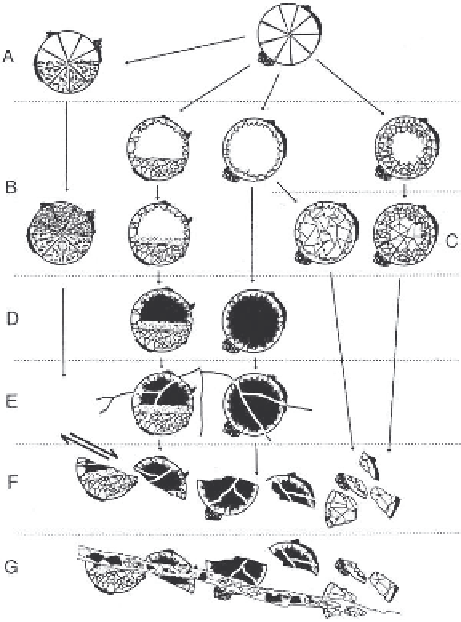Geology Reference
In-Depth Information
Fig. 7.15.
Diagenetic changes of coral skeletons over time
dem-
onstrated by diagenetic patterns of dendroid scleractinian cor-
als. The sketch summarizes different preservation types and the
course of diagenetic processes. The generalized drawings are
based on thin sections (see Pl. 36/4) of Cretaceous coral lime-
stones used as building stones in the giant wall of the Hittite
capital Hattusa near Bogazköy, central Turkey.
A:
The septal structure of the originally aragonitic dendroid
corals showing biogenic encrustations is rarely completely pre-
served, whereby a geopetal infill indicates toppling of the cor-
allites.
B:
Preservation of coral structures can be enhanced by the pre-
cipitation of fine-crystalline drusy calcite mosaics between the
septa. More often, however, the interior of the corallites is com-
pletely dissolved, producing open molds. The molds are stabi-
lized by variously thick interior cement tapestries. Coral disso-
lution may occur under meteoric conditions both in subaerial
and burial environments. The tapestries at the bottom of some
molds are covered by gray crystal silt pointing to dissolution in
a near-surface burial setting influenced by meteoric-vadose wa-
ters.
C:
Some of the molds have been completely occluded by blocky
burial cements.
D:
Still open molds are now filled with red internal sediment,
in places overlying the gray crystal silt. The red sediment is
unfossiliferous weakly laminated micrite that might represent
a reworked karstic residual sediment.
E:
This stage is characterized by the formation of calcite-filled
microcracks transecting both corals and packstone matrix dur-
ing increasing burial conditions.
F:
Deep burial compaction and shearing produces angular fragments showing plastic bending and grain breakage.
G:
The last stage is characterized by tectonic fissures filled with clasts consisting of reworked corals and matrix. After Flügel
und Flügel-Kahler (1997).
time are manifested by cement successions visible on
small- and medium scales as well as by large-scale
trends in mineralogy, cementation, and porosity due to
shifts of diagenetic environments during rock history.
Examples are shown in Fig. 7.15 and in Pl. 35.
ing diagenetic features to changing diagenetic environ-
ments (Schroeder 1986; Koch and Schorr 1986) and
provides a more profound understanding of porosity
evolution.
7.5 Diagenetic Textures
“Gone are the days when the carbonate petrogra-
phers were fully content in distinguishing cement A and
cement B“ (Schroeder 1988). For a long time these
terms were used in distinguishing first stage cement,
generally regarded as early diagenetic, and second stage
cement, considered to be late diagenetic in origin (Graf
and Lamar 1950). Precise petrographical thin-section
analyses and cathodoluminescence studies demonstrate
that a simple two-fold classification gives only a very
rough and often incorrect picture.
Diagenetic stages are indicated by the superposi-
tion of different mineral phases, or by differences within
cement minerals (Braithwaite 1993). Another pitfall in
recognizing small-scale diagenetic successions is spa-
tial variation within carbonate units (Pl. 35). Spatial
variations increase in the course of diagenesis over time,
resulting in a highly complex pattern of cementation,
dissolution, and porosity development. The
petro-
genetogram
, a time-space flow diagram ascribes vary-
The most important processes occurring in subsurface
carbonates are compaction and pressure solution. Burial
of noncemented carbonate sediments under an increas-
ing burden results in compaction and then in pressure
solution. The specific criteria of these processes can be
recognized on different scales including thin sections.
During
mechanical compaction
, strain is concentrated
at grain contacts. Grains may behave in either a brittle
or a ductile fashion.
Early cementation protects grains against compac-
tion and pressure solution. Mechanical compaction
eventually can continue on to chemical compaction if
the grains begin to dissolve at their contacts.
Chemical
compaction
in lithified limestones leads to
pressure so-
lution
generating dissolution seams and stylolites. Ref-
erences on mechanical and chemical compaction are
listed in Box 7.8.

